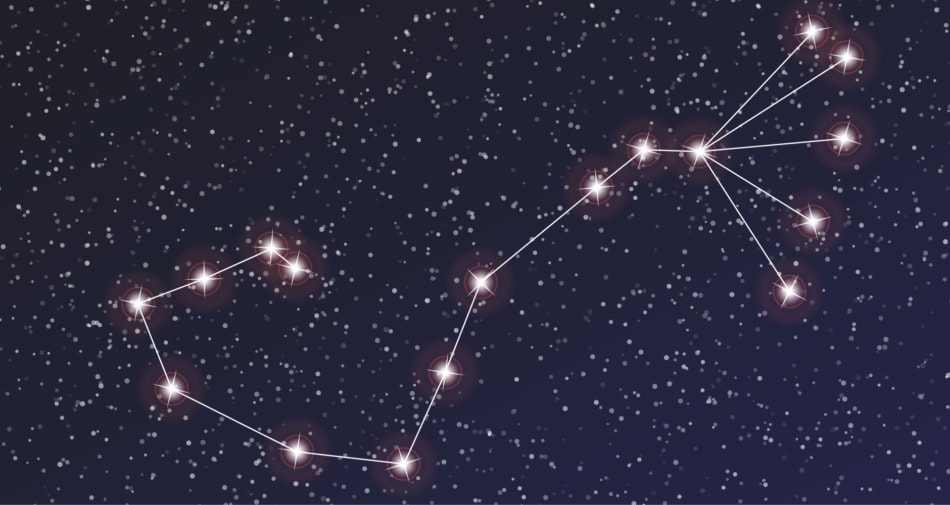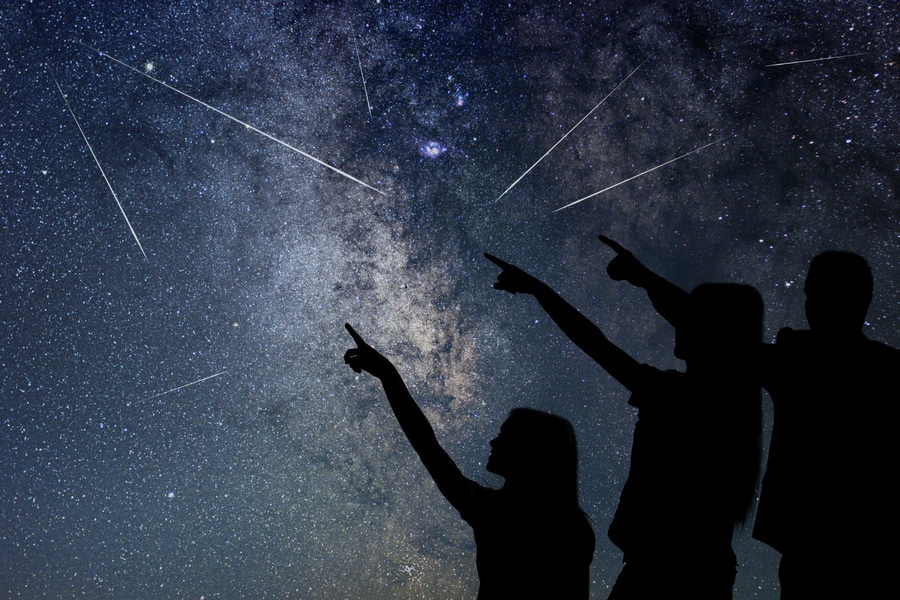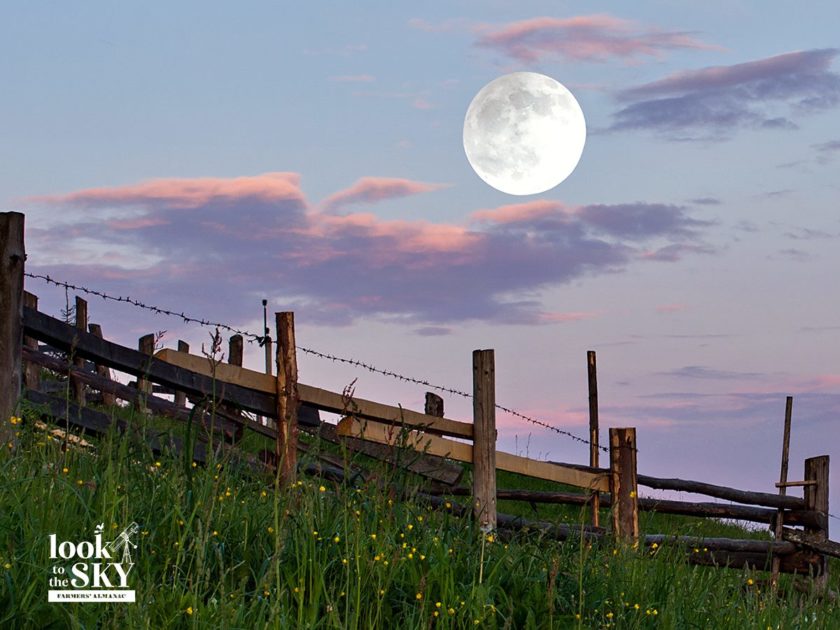July’s night sky will contain three major events. The first will be the largest full Moon of the year (The Full Buck Moon). The second will be when Mercury seems to disappear. (It’s called “superior conjunction” in astronomy.) The third will be a combination of two meteor showers as they reach peak activity. This may be the best shot at catching a shooting star this summer! (There is another meteor shower due in August, but the light of the full Moon around the same time will obscure its visibility.) See details below.
Bookmark this page and refer to it over the course of the next few weeks. Click on any of the planet names, constellations, or astronomy terms to learn more about each.
If you’re interested in locating a particular planet in the sky throughout the year, consult our visible planets guide.
The following is calendar of sky events for July 2022. Times and locations are Eastern Daylight and 40° north of the equator, respectively.
July 1 – Venus, Aldebaran (in Taurus), and Mercury
Look for Venus approximately 40 minutes before sunrise. (Check your local sunrise time.) From June 29th through July 3rd, Venus is very close to the 1st-magnitude star Aldebaran (The bull’s eye in the constellation Taurus). By sunrise, Venus will still be visible, standing a little more than 20° above the eastern horizon. You may also catch a glimpse of Mercury, which will be barely visible low in bright morning twilight as July begins. Look for Mercury about thirteen degrees to the lower left of Venus. Within a few days the planet will disappear into the Sun’s glare. In this way Mercury is the first planet to depart from the Parade of Planets, a rare sky event that many readers witnessed at the end of June.
July 4 – Earth at Aphelion
Earth’s orbit will reach its farthest point from the Sun at 3:11 a.m. For reference, our planet will be 3.3% farther from the Sun than it was at perihelion (when it’s closest to it) this past January. As a result, the Sun shines 6.5% dimmer—which may be hard to believe on a hot July day!
Note: Aphelion has no effect whatsoever on the Earth’s climate. Our seasons are controlled by the tilt of the Earth’s axis. We are warm in the summer because the Northern Hemisphere is tilted toward the Sun and cold in the winter because the Northern Hemisphere is turned away from the Sun. The 3.3% difference in the Earth’s distance plays no role in day-to-day weather changes. Each year we are farthest from the Sun in July and closest to it in January. Like the seasons, the dates differ slightly from one year to the next. (Generally speaking, we are closest to the Sun around New Year’s Day and farthest from it around Independence Day.)
July 6 – First Quarter Moon at 10:14 p.m.
July 13 – Full Buck Moon Super Supermoon at 2:38 p.m.
While this will be the “biggest” full Moon of 2022, the variation of the Moon’s distance will not be apparent to observers. (Read about the mysterious “Moon illusion” phenomenon here.) However the Moon’s closeness to Earth does dramatically affect the tides, which may cause severe coastal flooding.
At 3 a.m. on this day the Moon will arrive at perigee. This means that the Moon will get the closest it will come to Earth in all of 2022 (Only 221,994 miles away). Its gravitational pull creates extreme high and low ocean tides. Such a tide is known as a perigean spring tide. The word spring is derived from the German springen which means to “spring up.” (It is not a reference to the spring season.) Any coastal storm at sea around this time will almost certainly aggravate coastal flooding problems.
A spring tide occurs whenever the Moon is at or near full or new phase. The alignment of the Sun/Moon/Earth (or Sun/Earth/Moon) causes the tides to run a bit higher than at other times of the month. The combined pull of the Sun and Moon on the oceans causes a greater range of the tides—compared to other times of the month when the alignment is less exact. If the Moon happens to be at or near perigee at the time of full Moon or new Moon, the tides tend to be noticeably higher as compared to other spring tides.
Places that are located near and along ocean shorelines will be most prone to flooding, especially along the Atlantic Seaboard where a coastal storm or tropical cyclone may aggravate the situation by producing higher-than-normal tides on top of the already higher-than-normal water levels.
Tidal heights vary from one coastal location to another, depending on the topography. Historically, the “Saxby Gale” of 1869 is often referenced when unusually high tides coincide with a potent storm. (Read more about the Saxy Gale.)
July 15 – Saturn And The Moon
At 11 p.m., look for the nearly full Moon in the east-southeast sky. Saturn will be situated six degrees (three fingers’ width of your outstretched hand) above it. By late evening, the ringed wonder will be prominent low in the southeastern sky, especially because it will be in an otherwise dim region of the heavens.
Through a telescope, you may be able to see Saturn’s rings, which will be about 13° open. Saturn seems to be growing slightly in size as the Earth swings around its orbit towards it. The best telescopic views come well after midnight as the planet nears the meridian in the south.
General note about Saturn in July: The best views come just prior to the first light of dawn, roughly two hours before sunrise, when Saturn appears highest in the sky (toward the south). The rings are only visible using optical aid; those with telescopes will be able to get a glimpse of them using a 30x magnification. Higher magnification will bring them out even more. With a 3-inch telescope, use 75x. For a 6-inch telescope, use 150x.
Unfortunately, the rings are slowly closing to our line of sight. By 2025 they will be turned edge-on to our Earthly perspective and will be practically invisible, even in large telescopes. The rings will be fully opened to us (27-degrees) in 2033.
July 16 – Mercury at Superior Conjunction
Mercury reaches superior conjunction. This means that the planet Mercury will disappear from our view as it travels in its orbit on the other side of the Sun. As a result of this movement, the planet will emerge later in the month in the evening sky (as opposed to being visible in the morning sky).
July 18 – Jupiter and The Moon
Just before midnight, look low toward the eastern horizon for the waning gibbous Moon. Jupiter will be shining brightly above it as it resides within the dim stars of Pisces. If you are not able to see it, due to obstructions or low-altitude haze on the horizon, wait until approximately 2 a.m. and look again. By that time it should be clearer in the sky.
The best time to view Jupiter, especially if you have a telescope, is when its high in the south around two hours before sunrise. (Check your local sunrise time.)
For a sense of how Jupiter rises throughout the month: At the start of July, it rises at around 12:30 a.m. but by the end of the month it rises earlier in the night, at around 10:40 p.m.
The giant planet seems to stay stationary with respect to the background stars while Earth hurtles almost straight toward it over the course of July. Already brighter than any star, Jupiter brightens from magnitude -2.4 to -2.7 as we approach it. In a telescope, it will appear to swell by nine percent. (Jupiter will continue to brighten and enlarge a bit for two more months until its September 26th opposition.)
July 20 – Last Quarter Moon at 10:19 a.m.
July 21 – Mars And The Moon
In the predawn east-southeast sky this morning, you’ll find the Moon. Mars will be about three degrees to the left (as it treks toward the evening sky). During month Mars will have noticeably brightened from magnitude +0.5 to +0.2. But even in telescopes its disk is still minuscule and essentially featureless. (Mars will double in size by the time it arrives at opposition in early December.)
General note about Mars through the month: As July begins, the fire-colored planet rising on the east-northeast horizon at 1:30 a.m. but as July ends it rises before 12:30 a.m. While Mars shifts from Pisces eastward into Aries, the background constellations also appear to progress westward. These two motions partially cancel out, so Mars won’t appear to change position much from morning to morning with respect to your horizon and local landmarks.
July 22 – Antares (within Scorpius, Scorpio, the Scorpion)
As darkness falls, look low in the southern sky for Scorpius (the scorpion). Scorpius, unlike most constellations, is composed of many bright stars that may be seen by the naked eye. They are aligned in a fish-hook shape that looks very much like the shape of the creature it represents–a scorpion.
The upper stars of Scorpius form its body. Its tail slants toward the horizon, then curves to the left and upward. Its fine stream of stars ends in a wide pair that marks the scorpion’s stinger. These two stars are sometimes referred to as the “cat’s eyes” because they resemble the eyes of a cat staring at you in the darkness.

The Scorpion’s brightest star is the first-magnitude Antares. It is often called the “rival of Mars”—not because of its brightness (in fact, there are times when Mars shines brighter than this star) but because Antares shines with a true red hue. (Mars, which is typically thought of as red, actually shines with a yellow-orange luster.) In the time of Confucius, the Chinese called this star Ta Who, “The Great Fire.”
Antares is a red supergiant star, about 87,000 times more luminous and about 700 times the size of our Sun. If the Sun were shrunk down to the size of a baseball, Antares would be a globe measuring nearly 170 feet in diameter. A globe, however, suggests something that is solid and there is apparently nothing solid about Antares, as its overall density is less than one-millionth that of the Sun.
July 24 – Mercury
Look for Mercury 30 minutes after sunset on the west-northwest horizon. Use binoculars. Mercury will be visible throughout this final week of July.
July 26 – Venus And The Moon
Early risers will see a lovely pairing of the crescent Moon with dazzling Venus (approximately four degrees below it). Venus will be four degrees below the Moon’s slender sliver.
July 28 – New Moon at 1:55 p.m.
July 28-30 – Two Meteor Showers Peak
On the nights of July 28 and 29, into the early hours of the next mornings, look to the Southern sky. The South Delta Aquarid shower, which emanates from the constellation Aquarius, will reach its maximum during the hours of 1am-4am. Also peaking around this time is the Alpha Capricornid shower, which emanates from the constellation Capricornus. There will be a high proportion of bright meteors.
The Moon being in its “new” phase combined with these two meteor shower reaching their peaks makes for a great opportunity to catch a shooting star. (During a new Moon phase the Moon is barely illuminated. Therefore its brightness does not obscure the view of stars.)
Because the Aquarius and Capricornids are southern constellations, those in the southern US states have a bit of an advantage. But hourly rates are low, so there really won’t be many more meteors to be seen based on location. A clear sky matters more!

There are actually about a half dozen meteor showers that are active from mid-July through mid-August, so the odds are reasonably good that if the sky is clear and your location is free of bright lights (and the Moon is not too bright) you will likely see several meteors or more during an hour’s watch.
The most impressive meteor shower during the summer is usually the Perseid Meteor Shower that peaks on August 11-12. (They can produce anywhere from 45 to 90 meteors per hour.) However, as luck would have it, this year’s Perseids may not be visible—due to the brightness full moon of August 11th. Only the brightest Perseid streaks will be able to be seen. The fainter meteors will be squelched by the bright moonlight.
General note about meteor showers throughout the year: For reasons astronomers don’t fully understand, there are far more meteor showers (both major and minor) that appear during the second half of the year (July through December) as opposed to the first half (January through June). From mid-July through mid-August, the number of minor meteor displays are quite abundant compared to other times of the year.
Our schedule is adapted from “Skylog,” a regular feature appearing in Natural History magazine, written by Joe Rao since 1995.

